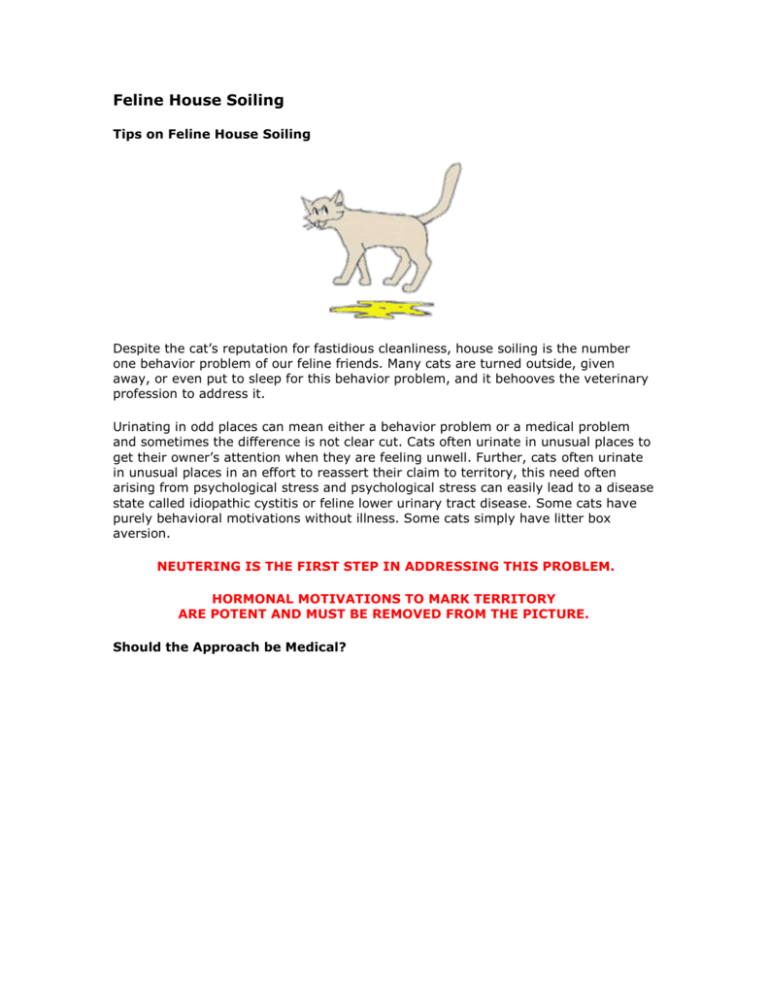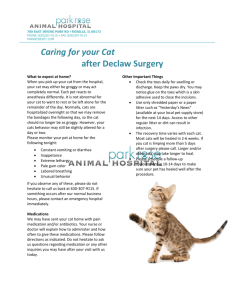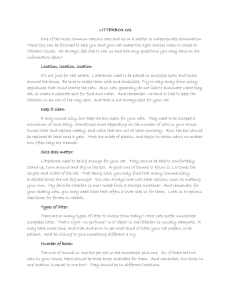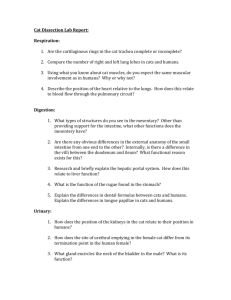Feline House Soiling
advertisement

Feline House Soiling Tips on Feline House Soiling Despite the cat’s reputation for fastidious cleanliness, house soiling is the number one behavior problem of our feline friends. Many cats are turned outside, given away, or even put to sleep for this behavior problem, and it behooves the veterinary profession to address it. Urinating in odd places can mean either a behavior problem or a medical problem and sometimes the difference is not clear cut. Cats often urinate in unusual places to get their owner’s attention when they are feeling unwell. Further, cats often urinate in unusual places in an effort to reassert their claim to territory, this need often arising from psychological stress and psychological stress can easily lead to a disease state called idiopathic cystitis or feline lower urinary tract disease. Some cats have purely behavioral motivations without illness. Some cats simply have litter box aversion. NEUTERING IS THE FIRST STEP IN ADDRESSING THIS PROBLEM. HORMONAL MOTIVATIONS TO MARK TERRITORY ARE POTENT AND MUST BE REMOVED FROM THE PICTURE. Should the Approach be Medical? Feline lower urinary tract disease (also called feline idiopathic cystitis and formerly referred to as feline urologic syndrome) involves straining to urinate, genital licking/discomfort, bloody urine, and often urinating in unusual places. There are many causes for this syndrome, including psychological stress. It may be hard to determine if a cat urinating outside the litter box has this syndrome and it is important to observe for the signs listed in addition to inappropriate urination. Cats with this syndrome often (but not always) receive a medically oriented approach addressing inflammation in the bladder. Your veterinarian should evaluate your cat before you conclude that the problem is behavioral and you embark on a long-term behavioral approach. Urine Marking / Territorial Anxiety Cats use urination and defecation as a means of communication with other cats. By leaving their mark, they are telling other cats “I was here on this date at this time.” Other cats may then know this land has been claimed (or has not been recently claimed) and may act accordingly. Psychological stress, such as the presence of other cats, prolonged absence of the owner (who is usually viewed as a parent by the pet cat), or other problems may create a need for a cat to reassert a territorial claim. Signs that this kind of stress is causing the problem might include some or all of the following: Spraying on an upright surface. Urinating in the litter box sometimes and sometimes urinating elsewhere (as opposed to never using the box at all). Defecating in the cat box but urinating outside the box. The cat (either male or female) is not neutered. There has been a change at home leading the cat to feel he/she must reassert his/her territorial boundaries. (Examples: a new pet has been added, a new roommate has been added, a recent move to a new home has occurred, remodeling has been done, the owner recently returned from a vacation, other neighborhood cats are visible or can be smelled in the yard.) The area marked is near a door or window. The problem did not start until new furniture was added or the furniture was rearranged. The cat appears to be responding to a punishment for another behavior. The area marked involves the owner’s bed or laundry. The area marked is the same each time. If any of these scenarios seem to fit, anti-anxiety medications may be tremendously helpful if the source of stress cannot be identified or cannot be altered. Medications commonly used as anti-anxiety treatments for inappropriate urination include: CLOMIPRAMINE This medication has been helpful in the treatment of obsessive-compulsive disease and depression in humans and has been approved for canine separation anxiety. It has come to be the first choice of many behaviorists for urine marking cats. It has shown effectiveness at near 90% and in most cats requires only once a day dosing. FLUOXETINE This medication is more commonly known as Prozac®. It has been used for feline urine marking and has been found of comparable efficacy to clomipramine. At least 8 weeks of treatment was required to achieve results in over 90% of cats and as long as they took the medication, they did not mark. If the medication is discontinued, marking may resume but is just as likely to respond a second time if the initial treatment was successful. Odor eliminators should be used in marked areas to discourage the cat’s tendency to return to these areas. Feliway Spray Recently a new alternative treatment has become available in the approach to territorial marking. Feliway spray is a spray for the area being marked rather than a medication administered to the cat. The spray consists of feline pheromones of the type that cats deposit when performing facial marking (i.e., rubbing their face/cheeks on things to scent mark). These pheromones have a general calming effect that helps neutralize the urge to urine mark. The product is available as a spray to apply to marked surfaces or as a plug-in diffuser that spreads pheromones through the room. A recent study was conducted involving 57 households with urine spraying cats. These cats marked on either vertical surfaces only or a combination of vertical and horizontal surfaces. Feliway spray was used twice a day on the urine marked areas for a one-month period. In one-third of households, urine marking stopped completely. In 57% of the households, urine marking was reduced and in 9.3% of households marking was unchanged. If Feliway spray is used, it cannot be expected to work if it is casually used. It should be used twice daily for at least one month before determining if it is effective. Litter Box Aversion Another reason why cats urinate or defecate outside the box is simply that the box is not acceptable to them. The box may be dirty, may not be adequately private, may smell funny or be uncomfortable. The following are clues that an inappropriate urination problem reflects litter box aversion. Urination does not involve spraying vertical surfaces. Both urination and defecation occur outside the litter box. Two or more cats share a litter box (the current litter box recommendation is one box per cat plus one extra). A new brand of litter is suddenly being used. The box is covered. A covered bathroom area is highly unnatural for cats as they prefer better lighting for elimination and odors are concentrated in an enclosed area such as a covered box. The box is not changed frequently. The cat has had a negative experience in the box (the cat was captured from the box to receive medication or be disciplined). The litter box is in a heavy household traffic area. A puppy or dog (or even a small child) is bothering the cat in the box. The litter box is located near a noisy appliance (such as a clothes dryer). Cats with this problem frequently require re-training to the box. As a first step, an additional box should be provided in a location separate from the original box. Many cats feel the box has been claimed by another household cat and are reluctant to use it or violate the other cat’s territory. Similarly, there may be some competition over the box between cats. In a single cat home, the cat may have experienced something unpleasant in association with the current litter box (molestation by a child or dog, loud noise etc.) and needs a new "bathroom area." It is important not to keep the cat’s food in a location near the box as the cat will not want to use the feeding area as a toilet. If the cat seems to have arthritis issues, a more shallow litter container may be better so the cat will not have to do any climbing or high-stepping. Obviously, any litter boxes should be scooped daily or even twice daily and kept as clean as possible. Clumping litter should be changed at least monthly and nonclumping litter should be changed twice weekly. The box should be washed with soapy water or water alone with no strong-smelling disinfectants that might be objectionable to the cat. We have had good experience with a litter additive called Cat Attract, which is an herbal product designed to return the cat to the box. We recommend including this product in the regimen. If the problem is difficulty in keeping the box clean, a selfcleaning box may be helpful. A litter box length should be at least one and a half times the length of the cat (not including the tail) so that the cat will have adequate space to maneuver and cover his or her excrement. As the next step, some other type of litter can be provided to see if the cat prefers a different brand or type. (Signs that the cat does not like the litter include: sitting on the plastic lip of the litter box to eliminate, failure to dig a hole in the litter, and/or shaking the litter off the paws after exiting the box.) If nothing seems to work, the cat should be confined in a small area, such as a large plastic carrier, with a litter box. The cat is gradually allowed more area after he/she has proven that he will use the box. (First, the carrier is the housing area, then a small room such as a bathroom or playpen is allowed, next a large room is added etc. until the cat again has his usual access.) If these tips are not effective in restoring the cat’s proper toilet behaviors, a behavior specialist should be called in. Please contact your veterinarian for the best consultant in your area.







